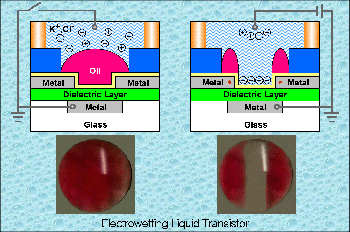Research on microfluidics widens the possibilities for electronic devices

Parting a tiny red sea at the University of Cincinnati: Today’s — and tomorrow’s — sophisticated electronic devices may hinge on our ability to control microdrops of liquid on a surface. This effect, called electrowetting, controls the contact angle of a liquid on a hydrophobic surface through the use of an electric field.
As recently published in Applied Physics Letters and featured on the cover of the journal, Andrew Steckl’s research on liquid-state-field-effect transistors (LiquiFETs) promises improvements in such things as "lab on a chip" devices. These tiny devices, reminiscent of the "Fantastic Voyage," can be introduced into the blood stream to monitor the blood’s chemistry. Steckl, a professor in the Department of Electrical and Computer Engineering in the College of Engineering, calls it "liquid logic" — using liquids to make electronic devices instead of solids.
One of the limitations of traditional health care instruments, for example, is that the information contained in the liquid (blood, in this example) must be translated into electrical signals that can be read in some kind of measuring device. Classical methods for this "translation" have used methods based on light and colorimetric measurement, direct optical sensing (using a video camera or detector) or combinations of optical excitation of fluorescent dyes.
Enter the liquid-state-field-effect transistors (LiquiFETs). Steckl and his doctoral student Duk Young Kim have designed and fabricated an electrowetting-based LiquiFET that operates in the liquid state and can directly convert charge-related information from the fluid into electronic, measurable signals. Such a device could co-exist in human body environment, for example, which is mostly liquid.
This technology could have applications in biology, health sciences and many other areas.
"In microelectronics, we usually think small," says Steckl. "But there are applications where you have to think large — like big, big flat-panel televisions, with flexible panels perhaps." Other applications might be for objects that have a peculiar shape, like the curves and corners of an automobile.
"Biomedical applications are also a natural," Steckl continues. "Biomedical devices are both analytical — where they take measurements — and therapeutic — where they deliver treatment." Analytical measurements need to be done in vitro (in glass, meaning in a test tube or other vessel) or in vivo (meaning in the body). Researchers are constantly striving for ways to optimize drug delivery to the patient. Devices perform many functions in drug delivery to measure the existing condition and to measure the effect of the medicine, for example. The doctor checks the condition after drug delivery, perhaps adjusts the dose, sees the effect and monitors the patient’s reaction.
"More research is needed, but perhaps the same device could be used for both analytical and therapeutic purposes," says Steckl. "With these devices, you have a real-time evaluation of effectiveness and a real-time adjustment of the dose. The faster that the doctor can know the effects of the drug, the better."
Source: University of Cincinnati





















